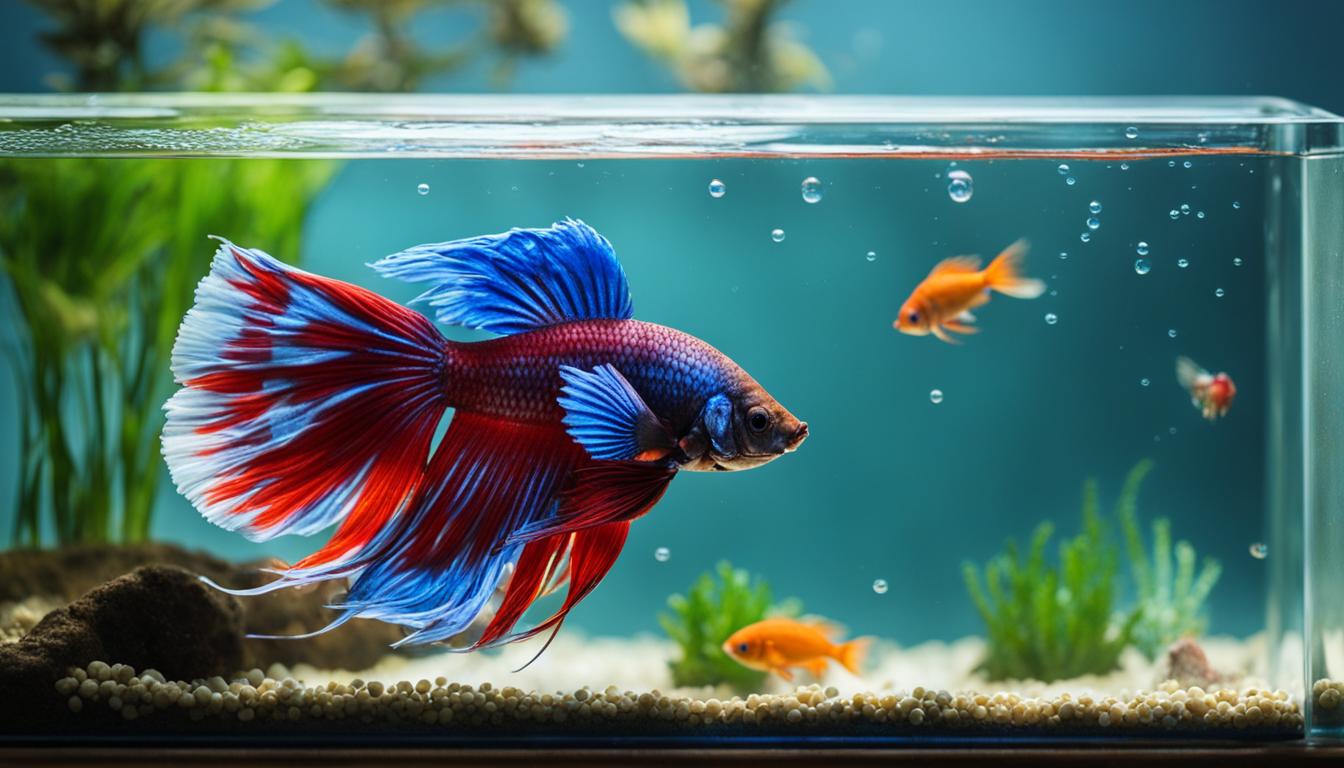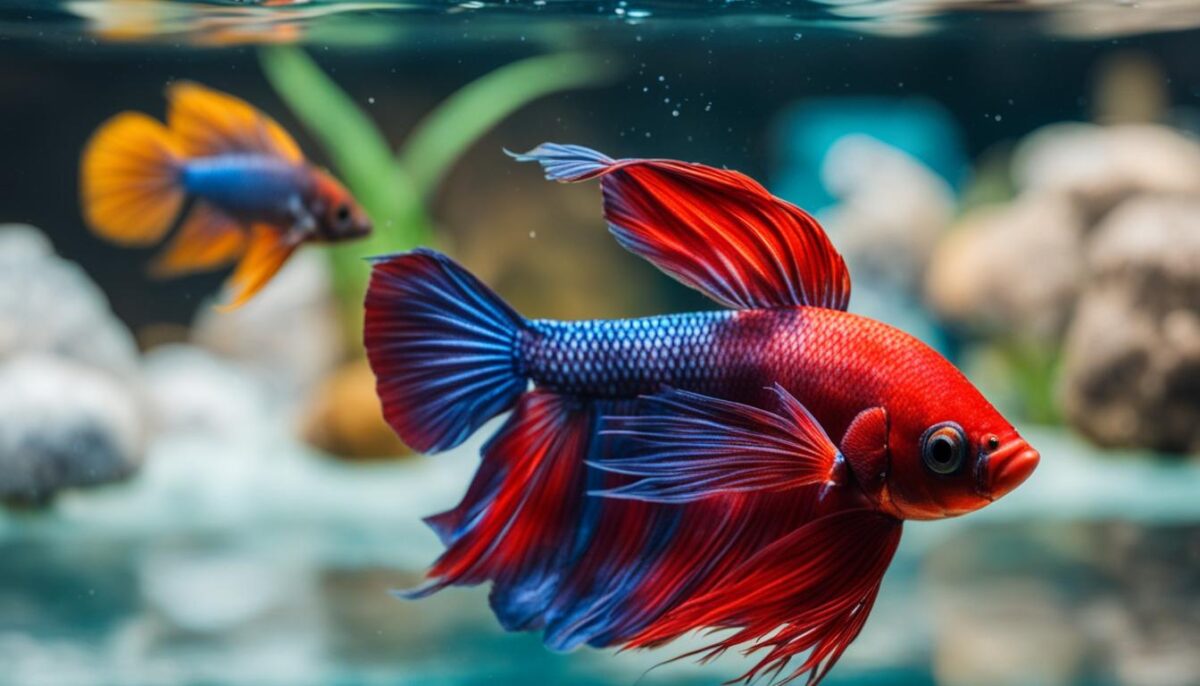Welcome, betta fish enthusiasts! If you’re new to caring for these beautiful aquatic creatures, one of the essential tasks you need to master is changing their water. Regular water changes are crucial for maintaining your betta fish’s health and creating a clean living environment. In this step-by-step guide, we’ll walk you through the process of changing your betta fish’s water, ensuring that you provide them with the best care possible.
Key Takeaways:
- Prepare fresh water in a clean container and use a water conditioner to remove harmful substances.
- Let the water reach room temperature or match the temperature of the current water in the betta’s container.
- Remove 25% of the water from the betta’s current container using a clean scoop or siphon hose.
- Refill the betta’s container with fresh, treated water slowly until it reaches the previous water level.
- Repeat water changes at least once a week, or more frequently if the container becomes dirty.
How to Prepare and Add New Water for Betta Fish Tank
Properly preparing and adding new water to your betta fish tank is crucial for maintaining a healthy and safe environment for your finned friend. Follow these steps to ensure your betta fish stays happy and thriving in its habitat.
1. Prepare Clean Water:
To start, prepare clean water in a bucket or container using fresh tap water. It’s important to ensure that the water is free from any harmful substances that can affect your betta fish’s health.
2. Rinse the Container:
Rinse the container thoroughly with tap water to remove any residue or impurities. This step helps maintain the cleanliness of the water and prevents contamination.
3. Use a Water Conditioner:
Add a water conditioner to the tap water to remove chlorine and other harmful chemicals. This helps create a safe and suitable environment for your betta fish.
4. Monitor the Water Temperature:
Monitor the temperature of the conditioned water and make sure it falls within the recommended range for betta fish, which is usually between 76-82°F (24-28°C). This ensures a comfortable and suitable temperature for your fish.
5. Slowly Add the Conditioned Water:
Slowly pour the conditioned water into the betta fish tank, taking care not to disturb the fish or create unnecessary turbulence. It’s important to maintain a stable and calm environment for your betta fish.
6. Reintroduce Tank Decorations:
While adding the conditioned water, you can also put back the tank decorations that were removed during the water change. This helps maintain a familiar and stimulating habitat for your betta fish.
7. Clean the Tank Filter:
If necessary, clean the tank filter before placing it back into the tank. A well-maintained filter ensures optimal water quality and a healthy living environment for your betta fish.
8. Close the Tank and Restore Essential Components:
Close the tank with the lid and turn on the heater, lights, and filter. This restores the essential components of the betta fish tank and provides the necessary conditions for your fish’s well-being.
Creating a clean and suitable watery habitat for your betta fish is essential for their health and happiness. By following these steps, you can ensure that the water in your betta fish tank is properly prepared and conducive to a thriving aquatic life.
How Often Should You Change Betta Fish Water?
Proper water maintenance is crucial for the health and well-being of your betta fish. The frequency of water changes depends on several factors, including the tank size, filter, feeding frequency, and the number of tank mates.
For tanks equipped with proper filtration systems, it is generally recommended to change 10-20% of the water every 2-3 weeks. This regular maintenance helps keep the water clean and ensures a suitable environment for your betta fish to thrive.
However, tanks without filters may require more frequent water changes, typically ranging from 30-50%. These tanks lack the filtration system’s ability to remove waste and impurities, making it important to refresh the water more regularly.
Feeding your betta fish in smaller meals and avoiding overfeeding can also help reduce the frequency of water changes. By providing just enough food that your betta can consume in a few minutes, you minimize the amount of uneaten food that can pollute the water, resulting in less frequent water changes.
The size of the tank and the number of fish in it also play a role in determining the frequency of water changes. Larger tanks with fewer fish tend to require fewer changes compared to smaller tanks with a higher fish population.
Tap water can be used for betta fish, but it must be treated with a water conditioner to remove harmful chemicals such as chlorine. The water conditioner neutralizes these substances, ensuring the water is safe and suitable for your betta fish.
In certain situations, full water changes may be necessary, depending on the tank size and the condition of the water. If the water becomes heavily polluted or contaminated, a complete water change can help restore a clean and healthy environment for your betta fish.
Regular water changes, in accordance with the specific requirements of your tank and fish, are essential for maintaining a clean and healthy habitat for your betta fish. By monitoring the factors that influence water change frequency and following the appropriate guidelines, you can provide your betta fish with the optimal care they need for a vibrant and happy life.
Conclusion
Regular water changes are crucial for keeping your betta fish healthy and happy. By following the step-by-step guide and understanding the factors that affect water change frequency, you can provide an optimal environment for your betta.
Remember to always use clean, conditioned water and monitor the temperature to ensure it’s suitable for your betta fish. Avoid tapping on the glass and be cautious with tank decorations to prevent any harm to your fish.
By adhering to these guidelines and staying consistent with water changes, you’ll contribute to the overall health and longevity of your beloved betta fish. So make water changes a priority in your betta fish care routine and enjoy the rewarding experience of a thriving aquatic pet.
FAQ
How often should I change the water for my betta fish?
The frequency of water changes depends on various factors like the tank size, filter, feeding frequency, and number of tank mates. For tanks with proper filtration, a 10-20% water change every 2-3 weeks is recommended. Tanks without filters may require more frequent water changes, up to 30-50%. Feeding your betta fish in smaller meals and avoiding overfeeding can reduce the frequency of water changes. The size of the tank and the number of fish also influence the frequency of water changes.
How should I prepare and add new water for my betta fish tank?
To prepare fresh water for your betta fish tank, start by filling a clean container with water and using a water conditioner to remove harmful substances. Let the water reach room temperature or match the temperature of the current water in the betta’s container. Then, remove 25% of the water from the betta’s current container using a clean scoop or siphon hose. Refill the betta’s container with fresh, treated water slowly until it reaches the previous water level. Finally, repeat water changes at least once a week, or more frequently if the container becomes dirty.
Can I use tap water for my betta fish?
Yes, tap water can be used for betta fish, but it needs to be treated with a water conditioner to remove harmful chemicals. Prepare clean water in a bucket or container, ensuring it is free from harmful substances. Rinse the container thoroughly with tap water. Use a water conditioner to remove chlorine and other harmful chemicals from the tap water. Monitor the temperature of the water and make sure it is within the recommended range for betta fish. Slowly add the conditioned water to the betta fish tank, while also adding back the tank decorations. Clean the tank filter if necessary before placing it back into the tank. Close the tank with the lid and turn on the heater, lights, and filter.
Is it necessary to do a full water change for my betta fish tank?
Full water changes can be done in certain situations, depending on the size of the tank and the condition of the water. However, regular water changes are essential for maintaining a healthy environment for betta fish. Following the step-by-step guide and understanding the factors that affect water change frequency will help ensure the well-being of your betta fish. By providing clean, conditioned water and monitoring the temperature, you can create an optimal habitat for your betta. Remember to avoid tapping on the glass and be mindful of the tank decorations to prevent harm to your betta fish. Following these guidelines and staying consistent with water changes will contribute to the overall health and longevity of your betta fish.

